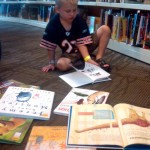Visual Learning: Illustrations in Your Children’s Books
 It’s Saturday morning—time to take my grandson, Brayden, to the library for a new set of picture books. Oh, how he loves books! First, we go around the house gathering all the books we need to return. As we review them, Brayden has a bit of emotion about letting some of his favorites go, but is encouraged about finding new books—new “friends”. We jump in the car, drive over and enjoy the return process before heading in to select new friends to check out and take home.
It’s Saturday morning—time to take my grandson, Brayden, to the library for a new set of picture books. Oh, how he loves books! First, we go around the house gathering all the books we need to return. As we review them, Brayden has a bit of emotion about letting some of his favorites go, but is encouraged about finding new books—new “friends”. We jump in the car, drive over and enjoy the return process before heading in to select new friends to check out and take home.
Brayden would be delighted to take home the first 40 books he finds, but I’m a bit more discerning in the selection process. Being an artist, I consider the quality of the illustrations before the story line; after doing research for my upcoming book, Being Visual, I better understand how important the visuals are and the ways they affect a child’s understanding.
Visual skills are critical to learning, but need to be developed. Reading and looking at picture books helps young children make important connections between words and images. Readers also need to gather information from images and place them in context. Young children rely on a book’s illustrations to help them understand the story. If those images don’t tell the story clearly or are not logical, children grow confused, frustrated and discouraged.
There are some incredible illustrators doing children’s books, but it is important that the art is there, first and foremost, to tell the story. When choosing books for your child, be sure the illustrations make sense, match the story line and increase your child’s understanding.
 |
Bette FetterFounder and CEO of Young Rembrandts and Author of Being Visual |











July 27, 2012 @ 1:28 am
Hi Bette,
Thank you very much for this post. I do agree with your thought that “Reading and looking at picture books helps young children make important connections between words and images.” It’s quite true that teaching a child is far more beneficial in case of visual teaching than that of textual teaching.